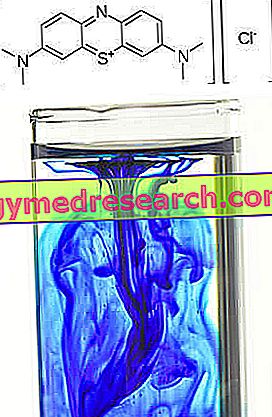Generality
Methylene blue (or methylthioninium chloride, if you prefer) is an organic compound characterized by a strong reducing activity. Thanks to this interesting feature, this active ingredient is successfully used in the treatment of methaemoglobinaemia.

Above: chemical structure of methylthioninium chloride. Bottom: methylene blue dropped into a test tube filled with water
The uses of methylene blue are not limited to the medical field. In fact, this compound is also used in analytical chemistry as an indicator in redox reactions, in sulfide analysis and as a peroxide generator.
Methylene blue is then used in aquaculture as a bactericidal and anti-protozoal agent and is also used as a dye, both in the biological field and in the textile and food industry.
Examples of Medicinal Specialties containing Methylene Blue
- Methylthioninium chloride Proveblue®
- Methylthioninium chloride Monico®
- Methylthioninium chloride SALF®
Indications
For what it uses
The use of methylene blue is indicated for the acute symptomatic treatment of drug-induced methaemoglobinaemia or chemical agents.
Furthermore, methylthioninium chloride can be used as a diagnostic for renal function, to calculate the glomerular filtration rate.
Warnings
Methylene blue must be injected only intravenously and very slowly, so as to avoid reaching high local concentrations, which can cause further methemoglobinemia.
Caution should be exercised when using methylene blue, as this compound may cause an exacerbation of haemolytic anemia and an increase in Heinz body formation.
Since methylene blue can promote the appearance of cardiac arrhythmias and hypotension, it is necessary to monitor blood pressure and the ECG trace during treatment with the drug.
Methylene blue gives the urine, faeces and skin a blue-green color. Such coloration of the skin could hinder the diagnosis of cyanosis (one of the main symptoms of methaemoglobinaemia, in fact), therefore care must be taken.
Methylene blue can cause side effects that can affect the ability to drive and use machines, therefore, these activities should be avoided.
Interactions
The use of methylene blue should be avoided in patients already on therapy with drugs capable of increasing serotonergic transmission, such as:
- Selective inhibitors of serotonin reuptake (or SSRIs);
- Venlafaxine;
- Buspirone;
- Mirtazapine;
- clomipramine;
- Bupropion.
However, before the administration of methylene blue it is always good to inform your doctor if you are taking - or have recently been taken - drugs of any kind, including medicines without a prescription, herbal products and homeopathic products .
Side effects
Methylene blue may cause several side effects, although not all patients experience them. The type of adverse effects and the intensity with which they occur can vary from one patient to another, also depending on the sensitivity of each individual to the same drug.
The main side effects that may occur following the use of methylene blue are listed below.
Blood and lymphatic system disorders
Following the intake of methylene blue may occur:
- Hemolytic anemia;
- bilirubin;
- Methemoglobinemia (only after administration of doses greater than or equal to 7mg / kg of body weight).
Cardiovascular disorders
Methylene blue may cause cardiac arrhythmias, hypertension or hypotension.
Nervous system disorders
Following the administration of methylene blue, headache, dizziness and tremors may occur.
Respiratory tract disorders
The administration of methylene blue may favor the onset of hypoxia, tachypnea or dyspnea.
Other side effects
Other side effects that could occur following the administration of methylene blue are:
- Anaphylactic reactions in sensitive individuals;
- Anxiety, confusion and agitation;
- mydriasis;
- Sweating;
- Urticaria;
- Changes in skin color, faeces and urine;
- Chest pain;
- Soft tissue necrosis at the injection site.
Action mechanism
As mentioned, methylene blue is a compound with a strong reducing activity.
Methaemoglobinaemia consists in the presence in our body of high levels of methaemoglobin. Methaemoglobin differs from hemoglobin due to the oxidation state of the iron contained within its heme group. In fact, in the hemoglobin there is the ferrous ion (Fe2 +), which allows the transport of oxygen; in methaemoglobin, on the other hand, the ferric ion (Fe3 +) is present, completely incapable of carrying oxygen.
Therefore, being a powerful reducing agent, methylene blue exerts its activity through the reduction of the ferric ion to ferrous ion, thus decreasing the levels of methemoglobin in the blood, hence the symptoms associated with methaemoglobinaemia.
Mode of Use - Posology
Methylene blue should only be administered intravenously and only by specialized personnel. The drug must under no circumstances be administered subcutaneously or intrathecally.
Symptomatic treatment of methaemoglobinaemia
When methylene blue is used for the acute symptomatic treatment of methaemoglobinaemia, the dose usually administered in infants with more than three months of life, in children, adolescents and adults (including the elderly) is 1-2 mg / kg of body weight. Generally, the duration of treatment is one day.
In infants with less than three months of life, on the other hand, the dose of drug usually used is 0.3-0.5 mg / kg of body weight.
In patients with kidney failure, the doctor may decide to give lower doses of the drug than those described above.
Diagnostic for kidney function
When methylene blue is used as a diagnostic agent to determine the glomerular filtration rate, the dose of active ingredient usually administered is 50-100 mg.
Pregnancy and breastfeeding
There are insufficient data regarding the human use of methylene blue during pregnancy. However, animal studies have shown that the compound has reproductive toxicity. For this reason, the use of the drug by pregnant women is generally contraindicated, except in the case where the doctor does not consider it absolutely necessary (for example, if the patient is in danger of death).
As for breastfeeding, however, it is not known whether methylene blue is excreted in breast milk, but a potential risk to the infant cannot be totally excluded. Therefore, as a precautionary measure, the use of the drug by breastfeeding mothers is contraindicated.
In the event that it is necessary to take the drug, breastfeeding must be suspended for at least six days after treatment with the same.
Contraindications
The use of methylene blue is contraindicated in the following cases:
- Known hypersensitivity to methylene blue itself or to any other coloring substance having a thiazine structure;
- In patients with a deficiency of the enzyme glucose-6-phosphate dehydrogenase (G6DP) or of the enzyme NADPH reductase;
- In patients suffering from methemoglobinemia caused by sodium nitrite used to treat cyanide poisoning;
- In patients with methemoglobinemia induced by chlorate poisoning;
- In patients suffering from severe renal insufficiency;
- Pregnant;
- During breastfeeding.



